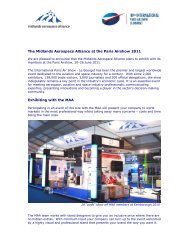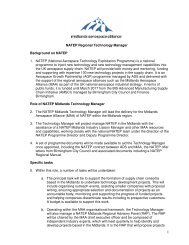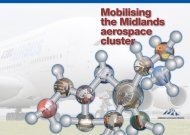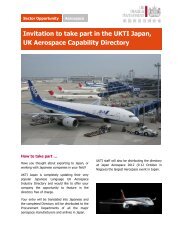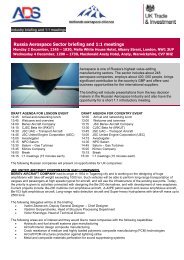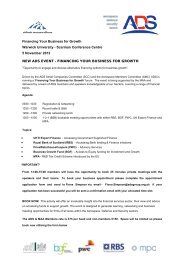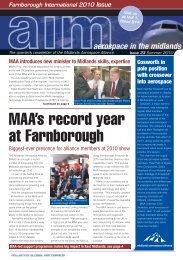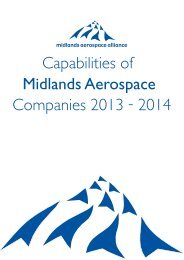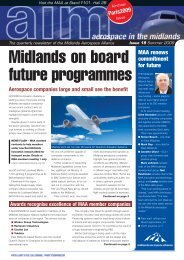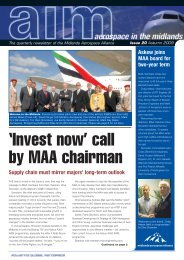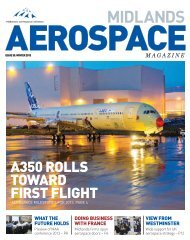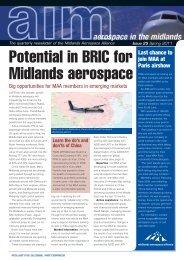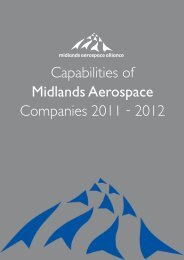new technology for aerospace
here - Midlands Aerospace Alliance
here - Midlands Aerospace Alliance
Create successful ePaper yourself
Turn your PDF publications into a flip-book with our unique Google optimized e-Paper software.
The University of Birmingham is well established as a world-class<br />
university. The university was founded on Birmingham’s science and<br />
engineering base and now boasts an annual income of more than<br />
£270 million and over 20,000 students. The Department of Metallurgy<br />
and Materials Science in particular is a leading centre in materials and<br />
manufacturing processes <strong>for</strong> <strong>aerospace</strong> applications.<br />
CASE STUDY: Manufacture of net shape components<br />
The university has developed two manufacturing technologies <strong>for</strong> the<br />
production of net shape components. These technologies have been<br />
specially developed to be transferred into industry.<br />
Direct laser fabrication<br />
This is a <strong>technology</strong> which can manufacture net shape components from<br />
their CAD files and metal powders using a laser in a single step. The<br />
laser is used as heat source to melt the metal powder which is injected<br />
into the laser focal point. At the same time the laser moves following the<br />
paths defined by the CAD file of the component so that a 3-D fully dense<br />
metal component is built layer by layer. No mould and little machining are<br />
required in this process.<br />
The turn-over time <strong>for</strong> manufacturing a component is between one and a<br />
few days, dependent on the component size. This <strong>technology</strong> has a great<br />
advantage in manufacturing a small batch of bespoke components and<br />
in precision-repair of worn out components. The repair of an aero-engine<br />
component <strong>for</strong> Rolls-Royce using this process has been estimated to<br />
save annual maintenance costs of more than £10m.<br />
Hot isostatic pressing (HIPping)<br />
Net shape HIPping is a <strong>technology</strong> which can produce fully dense net<br />
shape large components from metal powder (e.g Ti, Ni) in one step with<br />
little machining of the components involved. The mechanical properties<br />
obtained are similar to wrought (with suitable alloys) and surface finish<br />
and accuracy are as good as investment casting. No material is wasted<br />
except the mild steel which is used as the mould material.<br />
Rolls-Royce University Technology Centre <strong>for</strong> Materials<br />
The Department of Metallurgy and Materials incorporates the Rolls-Royce<br />
UTC <strong>for</strong> titanium based materials. The UTC runs several research projects with<br />
topics such as the development of a burn resistant alloy <strong>for</strong> aeroengines and the<br />
exploitation of intermetallic TiAl alloys’ high strength and low density properties.<br />
The alloys can be used <strong>for</strong> wrought and cast parts <strong>for</strong> the Joint Strike Fighter.<br />
Cold hearth refining<br />
The usage of this production method bears several advantages <strong>for</strong> the<br />
production of moving aircraft components. Weight can be saved and fatigue<br />
failures can be reduced. Metallic items normally ultimately fail by cracking,<br />
and inclusions can act as the starting points <strong>for</strong> cracks. An inclusion of about<br />
20 millionths of a gram can lead to failure in a component a metre long.<br />
Cold hearth refining is successful at preventing inclusions from reaching the final<br />
product. During the melting process, high density inclusions sink and become<br />
trapped in the solid ‘skull’ of material at the bottom of the hearth. Low density<br />
inclusions float and can be removed by interaction with the heat source. Neutral<br />
density inclusions dissolve in the molten material, given appropriate conditions.<br />
Corrosion of high strength aluminium airframe alloys<br />
The group investigates the corrosion of welds under consideration <strong>for</strong> the<br />
next generation of aircraft structures. This includes the mechanisms of<br />
corrosion, relating microstructure to corrosion susceptibility and examining<br />
methods to prevent corrosion, e.g. laser surface treatment and post-weld<br />
heat treatment.<br />
Fuel cells research at the Department of Chemical Engineering<br />
Aircraft demand more and more energy <strong>for</strong> cabin services like air, water,<br />
heat and power. In future electric aircraft this power will be supplied from an<br />
auxiliary power unit (APU) which will probably be a pressurized gas turbinefuel<br />
cell hybrid. Fuel cells can provide a more efficient energy supply, which<br />
saves fuel and weight on board. Fuel cell systems can also be operated<br />
independently from the propulsion engines, raising fuel efficiency.<br />
Researchers in the Department of Chemical Engineering have been working<br />
with Airbus to demonstrate fuel cell <strong>technology</strong> <strong>for</strong> APUs using kerosene<br />
JETA1.<br />
Contacts:<br />
Alison Morey<br />
Outreach Fellow<br />
Dept of Electronic, Electrical and<br />
Computer Engineering<br />
0121 414 4342<br />
bruceal@bham.ac.uk<br />
Fuel Cells:<br />
Dr Maria R Kosseva<br />
m.r.kosseva@bham.ac.uk<br />
0121 414 5360<br />
Prof Kevin Kendall<br />
Chemical Engineering<br />
k.kendall@bham.ac.uk<br />
0121 414 2739<br />
Links:<br />
University of Birmingham<br />
www.bham.ac.uk<br />
IRC in Materials Processing<br />
www.irc.bham.ac.uk<br />
6 7



